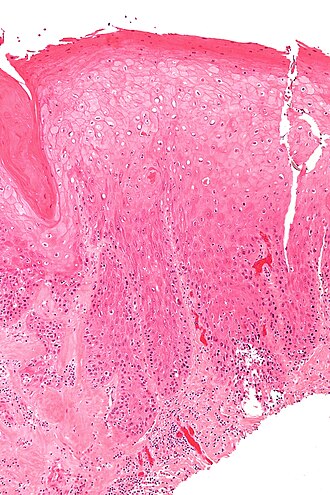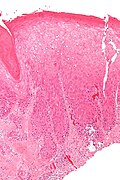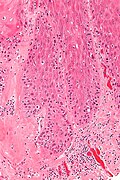Differentiated vulvar intraepithelial neoplasia
Jump to navigation
Jump to search
| Differentiated vulvar intraepithelial neoplasia | |
|---|---|
| Diagnosis in short | |
 Differentiated vulvar intraepithelial neoplasia. H&E stain. | |
|
| |
| LM | thickening of the stratum spinosum (acanthosis), elongation of rete ridges with bridging/anastomoses between rete ridges, nuclear atypia - esp. basal layer, nuclei in stratum corneum (parakeratosis), +/-atypical mitoses |
| LM DDx | vulvar squamous cell carcinoma, lichen sclerosus, classic vulvar intraepithelial neoplasia |
| IHC | p53 +ve, p16 -ve |
| Site | vulva |
|
| |
| Associated Dx | lichen sclerosus, vulvar squamous cell carcinoma |
| Prevalence | uncommon |
Differentiated vulvar intraepithelial neoplasia, abbreviated dVIN, is a pre-neoplastic pathology of the vulva typically arising in the context of lichen sclerosus.
It is also known as VIN simplex.[1]
General
Epidemiology:
- Associated with lichen sclerosus.
- Seen in older women.
Note:
Microscopic
Features:[3]
- Thickening of the stratum spinosum (acanthosis).
- Elongation of rete ridges with bridging/anastomoses between rete ridges.
- Nuclear atypia - esp. basal layer.
- Nuclei in stratum corneum (parakeratosis).
- +/-Atypical mitoses.
Notes:
- Not graded like classic VIN - considered high-grade by definition.[citation needed]
- Mnemonic BAD LAP: basal cell atypia, anastomosing rete ridges (bridging), dVIN, lichen sclerosus, acanthosis, parakeratosis.
DDx:
- Lichen sclerosus.
- Lichen simplex chronicus (squamous hyperplasia).
- Vulvar squamous cell carcinoma.
- Classic vulvar intraepithelial neoplasia.
Images
www:
IHC
- Differentiated VIN: p16 -ve, p53 +ve.[4]
- Classic VIN: p16 +ve, p53 -ve.
Note:
- p16 can be thought of as a poor man's HPV test.
See also
References
- ↑ Ruhul Quddus, M.; Xu, C.; Steinhoff, MM.; Zhang, C.; Lawrence, WD.; Sung, CJ. (Jun 2005). "Simplex (differentiated) type VIN: absence of p16INK4 supports its weak association with HPV and its probable precursor role in non-HPV related vulvar squamous cancers.". Histopathology 46 (6): 718-20. doi:10.1111/j.1365-2559.2005.02036.x. PMID 15910611.
- ↑ Yang, B.; Hart, WR. (Mar 2000). "Vulvar intraepithelial neoplasia of the simplex (differentiated) type: a clinicopathologic study including analysis of HPV and p53 expression.". Am J Surg Pathol 24 (3): 429-41. PMID 10716158.
- ↑ 3.0 3.1 van de Nieuwenhof, HP.; Bulten, J.; Hollema, H.; Dommerholt, RG.; Massuger, LF.; van der Zee, AG.; de Hullu, JA.; van Kempen, LC. (Feb 2011). "Differentiated vulvar intraepithelial neoplasia is often found in lesions, previously diagnosed as lichen sclerosus, which have progressed to vulvar squamous cell carcinoma.". Mod Pathol 24 (2): 297-305. doi:10.1038/modpathol.2010.192. PMID 21057461.
- ↑ 4.0 4.1 Pinto, AP.; Miron, A.; Yassin, Y.; Monte, N.; Woo, TY.; Mehra, KK.; Medeiros, F.; Crum, CP. (Mar 2010). "Differentiated vulvar intraepithelial neoplasia contains Tp53 mutations and is genetically linked to vulvar squamous cell carcinoma.". Mod Pathol 23 (3): 404-12. doi:10.1038/modpathol.2009.179. PMID 20062014.



